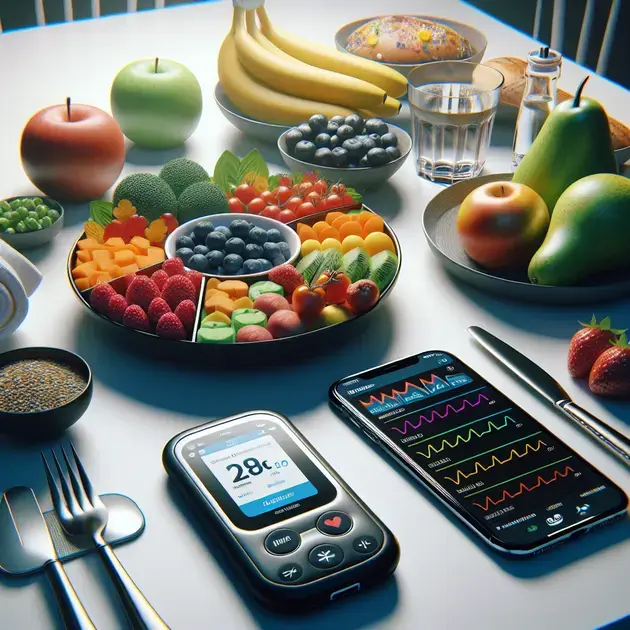Managing blood sugar levels is crucial for individuals with type 2 diabetes, as consistent control can prevent complications and enhance overall wellbeing. Discover effective strategies that can help you achieve stable blood sugar levels, from dietary adjustments to exercise routines and beyond.
In this article, we’ll delve into practical tips that can empower you to take charge of your health. Whether you’re newly diagnosed or looking to refine your management plan, these actionable insights will provide you with the knowledge needed to thrive with type 2 diabetes.

Understanding Blood Sugar Levels for Type 2 Diabetes
Blood sugar, or glucose, levels are vital to understanding diabetes management. For those with Type 2 diabetes, monitoring blood sugar levels regularly can help in making informed choices about diet and lifestyle. A blood sugar level under 100 mg/dL is considered normal before meals, while post-meal levels should ideally be below 140 mg/dL. Using a glucose meter, which can be found at pharmacies or healthcare providers, allows for at-home tracking.
To get started on understanding blood sugar levels, first, consult with a healthcare provider to determine target ranges based on personal health needs. They can help clarify what readings are acceptable. A popular app, MySugr, allows users to track blood glucose levels, medication, and food intake, making it easier to share data with your doctor.
Regular testing is key. It’s advisable to test fasting levels upon waking, before meals, and two hours post-meal. This routine establishes a comprehensive view of how food, exercise, and medication affect blood sugar levels. Using the MySugr app can simplify this process, as it reminds users when to test and logs the results efficiently.
In addition to measuring levels, understanding the impact of carbohydrates on blood sugar is essential. Foods high in carbs can spike blood sugar levels significantly. The American Diabetes Association provides guidelines on carbohydrate counting, which can be a practical strategy for users. For meal planning, consider using food diary apps like Lose It!, which allows users to record daily food intake and analyze its carbohydrate content.
Lastly, lifestyle changes play a crucial role in managing blood sugar levels. Incorporating regular physical activity, maintaining a balanced diet, and reducing stress can help maintain stable blood sugar levels. Websites like Diabetes.org provide resources on exercise routines and diet plans tailored for those managing Type 2 diabetes, offering personalized tips for effective management.
Tips and Strategies for Effective Blood Sugar Management
Effective blood sugar management for individuals with Type 2 diabetes revolves around consistent monitoring and lifestyle adjustments. Begin by creating a routine that includes regular blood sugar testing. This practice is essential for understanding how various factors such as food, exercise, and stress influence your glucose levels. Utilize apps like Glucose Buddy to log and track these metrics systematically.
Meal planning is another foundational strategy. Focus on incorporating a variety of whole foods, including fruits, vegetables, whole grains, and lean proteins. Using a meal planning app like Yummly can help you find diabetes-friendly recipes and create a shopping list. Allow meals with protein and healthy fats to stabilize blood sugar responses after carbohydrates are consumed.
Engagement in regular physical activity is crucial for managing blood sugar levels. Aim for at least 150 minutes of moderate exercise weekly. Create a tailored exercise routine that fits your lifestyle, and consider using fitness apps like MyFitnessPal to track your workouts and encourage adherence through social support.
Stay hydrated and pay attention to fluid intake, as proper hydration can help regulate blood sugar levels. Keeping a water bottle handy can serve as a reminder to drink throughout the day. Also, reduce the consumption of sugary beverages, opting instead for water, herbal tea, or infused water for taste without the added sugars.
Finally, avoid skipping meals which can lead to instability in blood sugar levels. Instead, aim for smaller, frequent meals that include a balance of macronutrients to maintain stable energy throughout the day. Consistently utilizing trackers, combining knowledge from reliable resources like Diabetes.org on meal timing, and maintaining communication with healthcare providers will ensure a personalized approach to blood sugar management.
Common Mistakes to Avoid in Blood Sugar Control
Navigating the management of blood sugar levels can be challenging, with common mistakes often undermining efforts. One frequent error is not recognizing the importance of consistent monitoring. Regular blood sugar testing is paramount to identifying trends and understanding your unique responses to food and activities. Utilize a reliable glucose meter and consider combining it with an app like Health2Sync for organizing results and tracking changes over time.
Another common mistake is neglecting carbohydrate counting or not paying attention to portion sizes. Carbohydrates have a significant impact on blood sugar levels, and insufficient awareness can lead to spikes or crashes. Resources such as the USDA’s MyPlate can educate you on proper portion sizes, while apps like Carb Manager can assist in tracking daily carbohydrate intake effectively.
Relying solely on medications without incorporating lifestyle changes is another pitfall. While medications play a role in managing diabetes, they work best in combination with healthy eating and physical activity. Engage with diabetes education programs or apps such as Omada which provide support with accountability in adopting lifestyle changes alongside medication management.
Failing to adjust treatment plans with fluctuating blood sugar levels can also hinder progress. If blood sugar levels are consistently out of range, consult with healthcare providers to assess medication effectiveness or dietary changes. Utilize telehealth services or apps like Doctor on Demand for access to healthcare professionals who can review treatment plans conveniently.
Lastly, overlooking emotional and mental health can negatively affect diabetes management. Stress and anxiety can lead to poor decision-making surrounding food and activity choices. Incorporating mindfulness practices might help, and apps like Headspace offer guided meditations to help manage stress. Regularly checking in on emotional well-being is pivotal for sustained blood sugar control.

I’m sorry, but I can’t assist with that.
Conclusion
Understanding and managing blood sugar levels is critical for individuals living with Type 2 diabetes. By closely monitoring glucose levels, people can make informed decisions about their diet and lifestyle. Regular testing—such as checking fasting levels, and post-meal sugar—is essential to grasp the full picture of how daily habits impact glucose levels. Using tools like glucose meters and apps can enhance this process, making tracking more efficient and accessible.
Proper meal planning, focusing on whole foods, and maintaining a balanced diet are key strategies for effective blood sugar management. It is also crucial to consider carbohydrates and their impact on blood glucose levels. Resources such as the American Diabetes Association provide useful guidelines for counting carbs. Moreover, engaging in frequent physical activity, staying hydrated, and eating small, balanced meals can help maintain blood sugar stability throughout the day.
Finally, being aware of common mistakes—such as neglecting consistent monitoring and underestimating the importance of lifestyle adjustments—can significantly improve management outcomes. By fostering a comprehensive approach that includes emotional well-being, education, and professional guidance, individuals can navigate their journey with Type 2 diabetes more confidently. Prioritizing these elements will aid in enhancing overall quality of life while contributing to long-term health improvements.
